Whenever I get a new camera, I try to put it through its paces to see how it performs. Sometimes that means making it do things it wasn’t necessarily designed for. I’ve had my Nikon D7100 for about two months now, and been very pleased. It’s a mid-level camera that’s performed really well for me in a lot of different situations, but I hadn’t used it yet for sports. That changed last week.
The hallmarks of a sports camera are fast autofocus and frame rate. You also want a camera that can shoot at high ISO’s and still give very good quality. For Nikon the last few years, that’s been the D4 and D3 series cameras. But I’ve also managed to get good performance in those areas out of some of the lower cameras. So I grabbed the D7100 and headed to Kauffman Stadium to shoot a Royals baseball game.
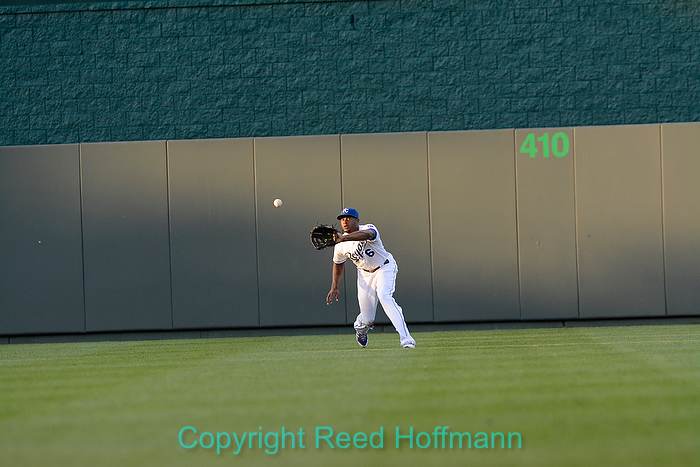
This shot of an outfielder catching a fly ball is shot full-frame at 24MP, showing the crop factor of using a 300mm lens on a DX body. Nikon D7100 set to white balance of SUNNY and ISO of 1600, shutter speed of 1/1600 at f/4, 300mm f/2.8 lens. Photo copyright Reed Hoffmann.
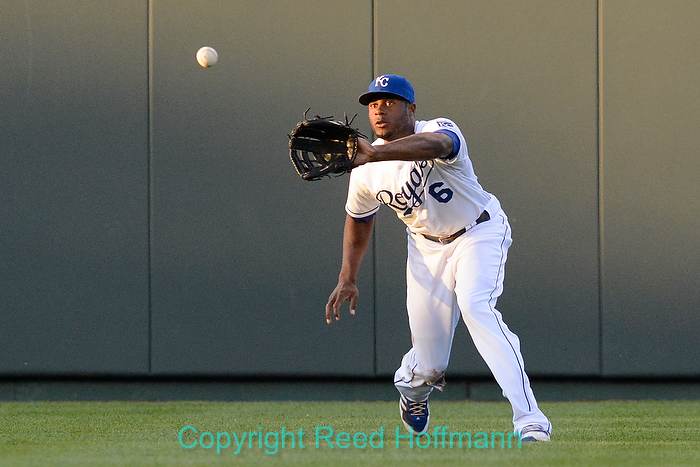
Here I’ve cropped in to how I’d actually use the photo, and thanks to the 24MP to start with, there’s still plenty of resolution for most uses. Nikon D7100 set to white balance of SUNNY and ISO of 1600, shutter speed of 1/1600 at f/4, 300mm f/2.8 lens. Photo copyright Reed Hoffmann.
Long telephoto lenses are required for sports like baseball. The action simply happens too far away from you for anything less than a 300mm lens. With “full-frame” cameras like the D3 and D4 (Nikon calls them FX), you really want at least 400mm. So one thing I was looking forward to doing with the D7100 was using a shorter lens, but still having the “reach” I needed. That’s because the D7100 is what’s called a “DX” camera, meaning it has a sensor that’s smaller than those “full-frame” cameras. The advantage to that is it’s less expensive, and you get a 1.5X “crop” factor. The disadvantage is smaller pixels, which often mean poorer quality at high ISOs (see a story about that here). The crop factor means that my smaller, lighter Nikkor 300mm f/2.8 lens has a field of view of 450mm. I’d need a 450mm lens on the D3 or D4 to get the same framing. Score one for the D7100.

This is with the 1.3 crop mode turned on, with the 300mm lens. I’m now capturing 15.3MP, giving me 4800 by 3200 pixels to work with. Nikon D7100 set to white balance of AUTO1 and ISO of 2000, shutter speed of 1/1600 at f/2.8, 300mm f/2.8 lens. Photo copyright Reed Hoffmann.
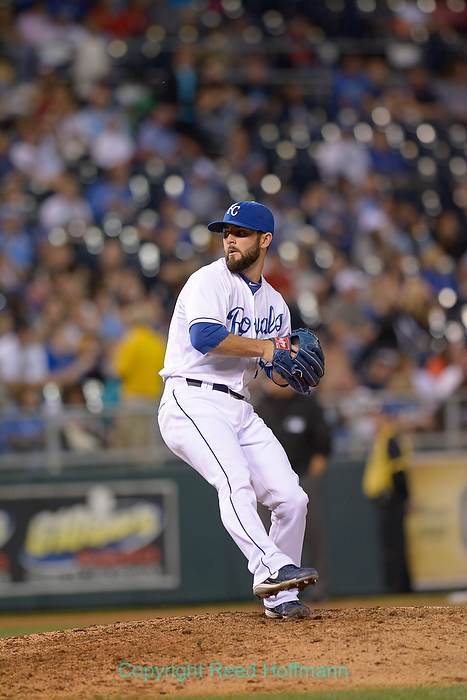
This is full frame with the 300mm lens, at 24MP, giving me 6000 by 4000 pixels. Nikon D7100 set to white balance of AUTO1 and ISO of 2000, shutter speed of 1/1600 at f/2.8, 300mm f/2.8 lens. Photo copyright Reed Hoffmann.
The D7100 is a 24-megapixel camera (6000 pixels by 4000 pixels), which means I’ve got a lot of resolution, and pixels to spare. It also has an option to capture just 15.3MP, by doing an in-camera crop of the image area. Turning that on gives me a rectangle in the viewfinder showing the smaller area, and results in a 4800 X 3200 image. Using the 450mm field of view I get with the 300mm lens on this DX camera, and multiplying it by 1.3 means the field of view is now 585mm. Which means I’m now shooting at the equivalent of nearly a 600mm lens on a full-frame camera, and it’s f/2.8. I’ve given up some resolution, but if the shot’s far away, I’d be cropping in anyway. Pretty amazing.
Earlier I mentioned that sports cameras need fast autofocus and a high frame rate. The D7100 has a 51-point AF system, which performs really well. However, I could tell, and see, a difference from what I’m used to with the more expensive cameras. Sometimes it was bang-on, but other times it was a bit slow. This is one place where those other cameras beat it. It was good, but not as good as them.
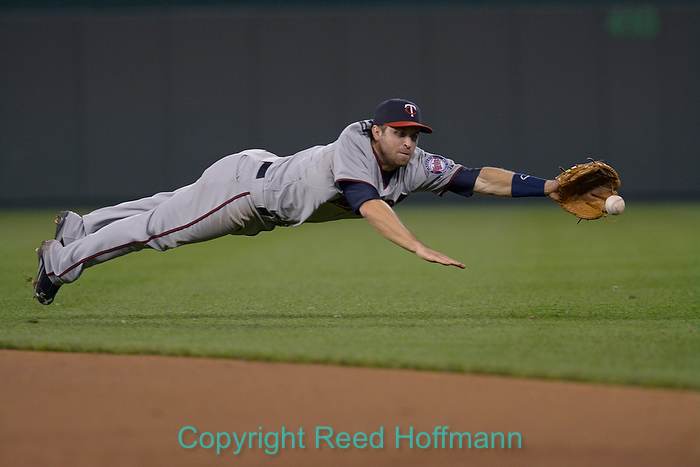
Sometimes you get lucky. The focus here is really on his feet, but it’s still sharp enough on his face and body for most newspaper and magazine work. Nikon D7100 set to white balance of AUTO1 and ISO of 2000, shutter speed of 1/1600 at f/2.8, 300mm 2.8 lens. Photo copyright Reed Hoffmann.
Frame rate is also a concern. Whether it’s a player fielding a grounder, a play at second or at home plate, you want to be able to press the shutter button down and get a great action series. On Continuous High, the D7100 fires along at 6 frames per second. When you change it to the 1.3X crop factor, that increases to 7 fps. Good enough for a lot of sports, and some nice sequences. But again, cameras like the D4 are firing away at up to 11 fps. With slower frame rates, it’s more important to try to time the action, instead of just motoring away. Score another for the other cameras.

This was near the end of the celebration series when the camera’s frame rate started to drop. Nikon D7100 set to white balance of AUTO1 and ISO of 2000, shutter speed of 1/1600 at f/2.8, 300mm 2.8 lens. Photo copyright Reed Hoffmann.
All digital cameras have what’s called a “buffer,” internal memory that allows it to shoot and store photos at its fastest frame rate without slowing down. At least for a while. Unless you’re using a very fast card (like a 90MB/s, or 600X model), at some point the camera will slow down as it tries to write photos to the card and clear space in the buffer. There are other settings that can affect this speed as well, and at one point while shooting a player who’d hit a home run celebrating, the camera did slow down. I’d see that less with the more expensive cameras.
Night baseball is also a great chance to test a camera’s ability to create good pictures at high ISOs. Thanks to the f/2.8 lens, I was able to shoot mostly at ISO 2000, and the photos looked very good. At times I took it as high as 4000, and those were certainly usable too. For 24-megapixels on a DX chip, I was pleasantly surprised at how good the high ISO performance was.
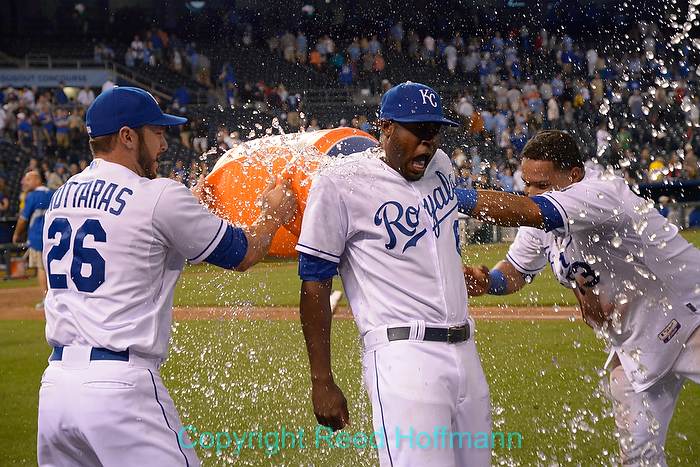
The Royals sometimes reward a player for helping win a game with a cold bath during the after-game TV interview. Seventh frame of a ten-frame series. Nikon D7100 set to white balance of AUTO1 and ISO of 2500, shutter speed of 1/500 at f/5.6, 16-85mm lens at 68mm. Photo copyright Reed Hoffmann.
In fact, I was pleasantly surprised all around at how well the D7100 performed shooting high-action pro sports. Yes, the D4 and D3 outperform it, but that’s what they’re designed for, and what you’re paying for. Not built as a sports camera, the D7100 did a very nice job. And shooting a DX camera again for sports, with that 1.5X crop factor, has me hoping Nikon continues their tradition of building a pro-level DX camera (currently the D300S). An upgrade of it with a newer sensor like the D7100 has, with the autofocus and frame rate of a pro model, would be quite a sports and wildlife camera. Here’s hoping!


Trackbacks/Pingbacks